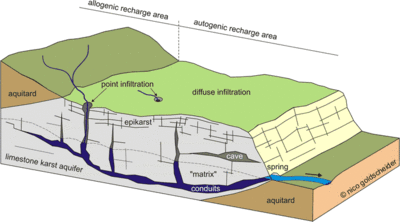Karst Springs
Introduction
A Karst topography is formed when rock is dissolved, causing small fissures within the geologic structure. This soluble rock material is often limestone, dolomite, or gypsum. This caustic solution creates sinkholes in the soil surface and as it digs further into the rock, can create underground caverns and passageways. This allows precipitation and surface runoff to penetrate the soil horizons and fill subterranean caverns. This water can be held within the underground caverns, or exit though hydric tunnels. Karst springs are formed when water exits the subterranean matrix (though eroded tunnels) and forms surface pools.
Importance of Karst Systems
Karst systems host a wide variety of endemic species due to the unique nature of the habitat. With anthropogenic disturbance taking a heavy toll on the natural landscape, the potential for great harm to the karst topography exists. The microclimate of a karst means that any inputs to the system will remain isolated within that pocket and persists for a much greater time period. An introduction of toxic pollutants could potentially kill an entire species inhabiting this kind of system. Furthermore, with the expansion of the urban environment, the interaction between man and karst is increasing. Whether it be urban sprawl (depleting water levels and the species that reside with it) or ecotourism, humans are interaction more heavily with karst landscapes.
Physio-chemical Environment
Chemical
The formation of the karst topography begins with the "carbon dioxide cascade." Rainfall absorbs CO2 from the atmosphere during droplet formation, while it falls as precipitation, or as it moves through the soil horizons. This forms carbonic acid (H2CO3).
H2O + CO2= H2CO3
As the acid comes in contact with the alkaline rock the two react, forming an aqueous solution that will further dissolve small channels within the soil. Slowly over decades channels will expand allowing larger volumes of water to pass through it. Due to the high solute concentrations within the water, karst systems are often found to be alkaline, having reacted with the calcareous environment and forming the karst.
Physical
The movement of water through any ecosystem effects the physical structure of that system. This is especially true for a karst. A karst is not only borne of the chemicals within water eroding away bedrock, but also the physical scrapping of rock due to water movement.
Flowing water within a karst can hold a significant load of microorganisms and nutrients. The transportation of which can yield changes in the biological and chemical environments both at the source and sink regions of the karst watershed.
Biological interactions
In addition to the abundance of microbial organisms found in a karst, there are a plethora of higher organisms as well. Bats, birds, reptiles; animals associated with cavernous habitats, reside in karst systems. Consequently, there exists an relationship between the higher order inhabitants of these subterranean landscapes and the microorganisms that rely on the biological activities of these organisms.
Pollution
Karst systems are one of the greatest suppliers of aquifers, with nearly 25% of the drinking water (in the United States) flowing through a karst. The rapid recharge of the subterranean aquifers does mean that little filtration may occur with certain water sources. This may lead to potential pollution and contamination hazards.
Are there important biological interactions that are important in this environment? Do these interactions influence microbial populations and their activities? How do these interactions influence other organisms? Describe biological interactions that might take place in this environment, using as many sections/subsections as you require. Look at other topics available in MicrobeWiki. Create links where relevant.
Microbial processes
The bacteria within the Karst landscape build and define the channels of the system. Through the cycling of carbon, carbon dioxide is utilized to build up, and break down calcium deposits. This action creates the sinkholes from which
What microbial processes define this environment? Describe microbial processes that are important in this habitat, adding sections/subsections as needed. Look at other topics in MicrobeWiki. Are some of these processes already described? Create links where relevant.
Key Microorganisms
Bacteria
Algae
As with any open air body of water, karst springs host a number of different algal species including cholorphyta and bacillariophyceae.
Fungi
Ascomycetes:
Histoplasma capsulatum is a fungus found in karst systems and is often associated with the presence of bats (Myotis spp.). This fungus grows on the guano of bats on the floor of caverns and Karst systems.
Also found in karsts are fungi of zygomycetes
Current Research
1)One study analyzed the bacterial diversity and community composition in three karst cave system with different hydrologic and chemical traits. Specifically, they looked at the assemblage of microbes by the use of the 16S rRNA genes for identification. Accroding to the study, "Unexpectedly high microbial phylotype richness was found even in the two pools without groundwater contact and with low concentrations of organic carbon and total cell numbers." The conclusion of the analysis was that karst water provides a means of bacteria from a terrestrial ecosystem to a freshwater habitat via subsurface flow.
2) Research is also being done to determine the relationship between aerobic and anaerobic strains of bacteria within a single ecosystem. 681 species within a community were analyzed using 16s rRNA identification 35 genera were identified, but few were observed to dominate within the habitat consistently.
3)Further research has been done to show the relation between terrestrial beat bog microbial communities and subterranean aquifers. In studying a site in Italy, it was discovered that there exists a high rate of biological transfer through karst waterways between terrestrial habitats.
Resources
Lecture on Karst Aquifers: University of Texas
References
Earth Science Institute. "What is Karst?". University of Texas at Austin.
Encyclopedia of Cave and Karst Science. "Microorganisms In Caves".
International Association of Hydrogeologists. "Karst Hydrology". IAH Karst Commission. 2009
The Karst Conservancy. "What is Karst?".
Kentucky Geological Survey. "Introduction to Karst Groundwater".
Edited by students of Angela Kent at the University of Illinois at Urbana-Champaign.


